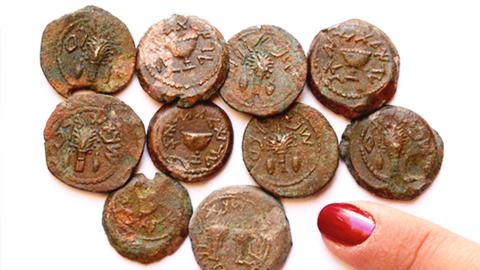
Treasure Trove of Ancient Jewish 'Freedom Coins' Just in Time for Passover
JERUSALEM, Israel – Hebrew University archaeologist Dr. Eilat Mazar uncovered a rare treasure trove of bronze coins from the time of the Jewish revolt against the Romans more than 1,900 years ago. They were found at the Ophel excavation in Jerusalem's Old City, located below the southern wall of the Temple Mount. The excavation was recently renewed after a four-year hiatus.
"A discovery like this – ancient coins bearing the words 'Freedom' and 'Redemption' – found right before the Jewish Festival of Freedom, Passover, begins is incredibly moving," she said.
Mazar, a third-generation archaeologist, loves sharing how her discoveries inexorably link the biblical history of Israel with the Jewish people.

Dr. Eilat Mazar, CBN News Interview, Screen Capture
These coins tell an extraordinary story.
Mazar explained that Jewish residents hid in a large cave from the Roman Empire's siege on Jerusalem – from 66 to 70 CE (AD) until the invaders destroyed the Second Temple and the city of Jerusalem.
The coins, she said, are the last remnants of the four-year Jewish revolt against the invading Roman Empire.
While several of the bronze coins date to the revolt's early years, the majority date from its final year, known as "Year Four," according to Mazar. During the final year, the Hebrew inscription was changed from "For the Freedom of Zion" to "For the Redemption of Zion," reflecting their state of mind as they hid from the Roman soldiers.
Mazar said the well-preserved coins are decorated with Jewish symbols, including the four biblical plant species: palm, myrtle, citron and willow. There's also an image of the goblet used in the Temple service. She attributed their state of preservation to the relatively short time they were used.
Just after the Six-Day War, her grandfather, Prof. Benjamin Mazar, discovered a similar trove of "Year Four" coins in excavations for Hebrew University's Institute of Archaeology. He found them near Robinson's Arch, close to the Western Wall, just after Jerusalem was reunited under Israeli sovereignty.

Prof. Ben Mazar in 1936, Photo, GPO archive, Kluger Zoltan
What Mazar finds extraordinary about this latest find is that the large cave dating to the Second Temple Period remained undiscovered for years. That makes the cave "a veritable time capsule of life in Jerusalem during the four years its residents fought off the Roman invasion."
These latest finds were discovered directly above a layer dating to the Hasmonean Period. A complete report of these finds will be published in the third volume of the Ophel excavations. Volume two is being published this week.
Mazar included the following information in her press release:
The Ophel excavations are located within the walls surrounding the Jerusalem National Park. The National Parks and Gardens Authority and the Eastern Jerusalem Development Company manage the park. The Herbert W. Armstrong College of Edmond, Oklahoma, funds the excavation. Students from the college come to Israel to take part in the excavations.
The Hebrew University of Jerusalem is Israel's leading academic and research institution, producing one-third of all civilian research in Israel.



